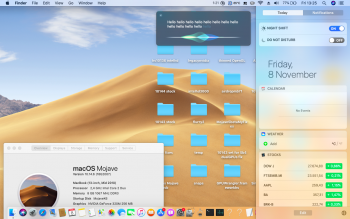Hi
@Bill Forest,
Copy "bkltpatch10.14.2.zip" ON YOUR DESKTOP and unziped it
You have now on your desktop a folder named bkltpatch10.14.2 with 4 files inside
Open Terminal and write (or copy) this:
Code:
cd desktop/bkltpatch10.14.2;
install.sh
This should work properly
On iMac7,1 and iMac8,1 (I have not tested on iMac 9.1) this does not work and gives Kernel Panic, 2 files should not be replaced but only "DisplayServices.framework"
Take a look at this:
Hi everybody I run a new thread because someone deleted my addition about this on the first page of the thread "macOS 10.14 Mojave on Unsupported Macs" perhaps thinking that my discovery was useless and not worth it! All is in the title! I have two unsupported iMac8,1 with macOS Mojave and I...

forums.macrumors.com
Hi,
I have an iMac 9,1 and just tried your method to fix the fact that the Brightness buttons (F1, F2) do not work after installing dosdude's Mojave patch (Mojave 10.14.6).
First I must say that I am a novice in working with Terminal, so I may have done something incorrectly. At any rate, I tried both the manual and automatic fixes, and now the F1/F2 buttons adjust the Brightness, but only for about 2 seconds. It will turn Brightness up or down, but after 2 seconds, it reverts to low level brightness.
Do you have any suggestions?
Here is what I get when I run it in automatic:
sudo /Users/name/Downloads/Fix\ Backlight\ control\ with\ F1-F2\ keys\ for\ iMac\ 7\,1\ \&\ 8\,1/install.sh
Password:
cp: DisplayServices.framework: No such file or directory
Kext with invalid signatured (-67054) allowed: <OSKext 0x7f8542d48800 [0x7fffa3f668e0]> { URL = "file:///System/Library/Extensions/AppleHDA.kext/", ID = "com.apple.driver.AppleHDA" }
kext file:///System/Library/Extensions/BJUSBLoad.kext/ is in hash exception list, allowing to load
kext file:///System/Library/Extensions/EPSONUSBPrintClass.kext/ is in hash exception list, allowing to load
Kext with invalid signatured (-67062) allowed: <OSKext 0x7f85443c5470 [0x7fffa3f668e0]> { URL = "file:///System/Library/Extensions/GeForceTesla.kext/", ID = "com.apple.GeForceTesla" }
kext file:///System/Library/Extensions/hp_designjet_series.kext/ is in hash exception list, allowing to load
kext file:///System/Library/Extensions/hp_Deskjet_io_enabler.kext/ is in hash exception list, allowing to load
kext file:///System/Library/Extensions/hp_fax_io.kext/ is in hash exception list, allowing to load
Kext with invalid signatured (-67062) allowed: <OSKext 0x7f85443eb2d0 [0x7fffa3f668e0]> { URL = "file:///System/Library/Extensions/hp_Inkjet1_io_enabler.kext/", ID = "com.hp.print.hpio.Inkjet1.kext" }
kext file:///System/Library/Extensions/hp_Inkjet3_io_enabler.kext/ is in hash exception list, allowing to load
kext file:///System/Library/Extensions/hp_Inkjet4_io_enabler.kext/ is in hash exception list, allowing to load
kext file:///System/Library/Extensions/hp_Inkjet7_io_enabler.kext/ is in hash exception list, allowing to load
kext file:///System/Library/Extensions/hp_Inkjet8_io_enabler.kext/ is in hash exception list, allowing to load
kext file:///System/Library/Extensions/hp_Inkjet_io_enabler.kext/ is in hash exception list, allowing to load
kext file:///System/Library/Extensions/hp_Officejet_io_enabler.kext/ is in hash exception list, allowing to load
kext file:///System/Library/Extensions/hp_Photosmart_io_enabler.kext/ is in hash exception list, allowing to load
kext file:///System/Library/Extensions/hp_qc_io_enabler.kext/ is in hash exception list, allowing to load
Kext with invalid signatured (-67054) allowed: <OSKext 0x7f85440e7680 [0x7fffa3f668e0]> { URL = "file:///System/Library/Extensions/IOUSBFamily.kext/", ID = "com.apple.iokit.IOUSBFamily" }
Kext with invalid signatured (-67054) allowed: <OSKext 0x7f85440edc70 [0x7fffa3f668e0]> { URL = "file:///System/Library/Extensions/IOUSBFamily.kext/Contents/PlugIns/AppleUSBMergeNub.kext/", ID = "com.apple.driver.AppleUSBMergeNub" }
Kext with invalid signatured (-67054) allowed: <OSKext 0x7f85440f0d30 [0x7fffa3f668e0]> { URL = "file:///System/Library/Extensions/IOUSBFamily.kext/Contents/PlugIns/IOUSBCompositeDriver.kext/", ID = "com.apple.driver.AppleUSBComposite" }
Kext with invalid signatured (-67054) allowed: <OSKext 0x7f85440f28b0 [0x7fffa3f668e0]> { URL = "file:///System/Library/Extensions/IOUSBFamily.kext/Contents/PlugIns/IOUSBHIDDriver.kext/", ID = "com.apple.iokit.IOUSBHIDDriver" }
Kext with invalid signatured (-67054) allowed: <OSKext 0x7f85440f8200 [0x7fffa3f668e0]> { URL = "file:///System/Library/Extensions/IOUSBFamily.kext/Contents/PlugIns/IOUSBUserClient.kext/", ID = "com.apple.iokit.IOUSBUserClient" }
Kext with invalid signatured (-67054) allowed: <OSKext 0x7f85440ea3c0 [0x7fffa3f668e0]> { URL = "file:///System/Library/Extensions/IOUSBHostFamily.kext/", ID = "com.apple.iokit.IOUSBHostFamily" }
kext file:///System/Library/Extensions/JMicronATA.kext/ is in hash exception list, allowing to load
kext file:///System/Library/Extensions/LexmarkUSBMerge.kext/ is in hash exception list, allowing to load
Kext with invalid signatured (-67062) allowed: <OSKext 0x7f854467a540 [0x7fffa3f668e0]> { URL = "file:///System/Library/Extensions/MacOSXCameraDriver.kext/", ID = "com.flipvideo.IOUSBCameraMassStorage" }
Kext with invalid signatured (-67062) allowed: <OSKext 0x7f85446a4ef0 [0x7fffa3f668e0]> { URL = "file:///Library/Extensions/LegacyUSBInjector.kext/", ID = "com.parrotgeek.LegacyUSBInjector" }
Kext with invalid signatured (-67030) allowed: <OSKext 0x7f854471e6c0 [0x7fffa3f668e0]> { URL = "file:///Library/Extensions/LegacyUSBVideoSupport.kext/", ID = "com.parrotgeek.LegacyUSBVideoSupport" }
Kext with invalid signatured (-67050) allowed: <OSKext 0x7f8544718c20 [0x7fffa3f668e0]> { URL = "file:///Library/Extensions/SIPManager.kext/", ID = "com.parrotgeek.SIPManager" }
Kext with invalid signatured (-67050) allowed: <OSKext 0x7fd0937539f0 [0x7fffa3f668e0]> { URL = "file:///Library/Extensions/SIPManager.kext/", ID = "com.parrotgeek.SIPManager" }
Kext with invalid signatured (-67054) allowed: <OSKext 0x7fd09351c330 [0x7fffa3f668e0]> { URL = "file:///System/Library/Extensions/IOUSBFamily.kext/", ID = "com.apple.iokit.IOUSBFamily" }
Kext with invalid signatured (-67054) allowed: <OSKext 0x7fd093527400 [0x7fffa3f668e0]> { URL = "file:///System/Library/Extensions/IOUSBFamily.kext/Contents/PlugIns/IOUSBHIDDriver.kext/", ID = "com.apple.iokit.IOUSBHIDDriver" }
Kext with invalid signatured (-67054) allowed: <OSKext 0x7fd09352bce0 [0x7fffa3f668e0]> { URL = "file:///System/Library/Extensions/IOUSBHostFamily.kext/", ID = "com.apple.iokit.IOUSBHostFamily" }
Kext with invalid signatured (-67054) allowed: <OSKext 0x7fd093525150 [0x7fffa3f668e0]> { URL = "file:///System/Library/Extensions/IOUSBFamily.kext/Contents/PlugIns/IOUSBCompositeDriver.kext/", ID = "com.apple.driver.AppleUSBComposite" }
Kext with invalid signatured (-67030) allowed: <OSKext 0x7fd09372c390 [0x7fffa3f668e0]> { URL = "file:///Library/Extensions/LegacyUSBVideoSupport.kext/", ID = "com.parrotgeek.LegacyUSBVideoSupport" }
Kext with invalid signatured (-67054) allowed: <OSKext 0x7fd093523690 [0x7fffa3f668e0]> { URL = "file:///System/Library/Extensions/IOUSBFamily.kext/Contents/PlugIns/AppleUSBMergeNub.kext/", ID = "com.apple.driver.AppleUSBMergeNub" }
Kext with invalid signatured (-67062) allowed: <OSKext 0x7fd09347f320 [0x7fffa3f668e0]> { URL = "file:///Library/Extensions/LegacyUSBInjector.kext/", ID = "com.parrotgeek.LegacyUSBInjector" }
kext file:///System/Library/Extensions/JMicronATA.kext/ is in hash exception list, allowing to load
/System/Library/Extensions/IOUSBHostFamily.kext/Contents/PlugIns/AppleUSBVHCIBCE.kext - dependency 'com.apple.driver.usb.AppleUSBVHCI' not found.
/System/Library/Extensions/IOUSBHostFamily.kext/Contents/PlugIns/AppleUSBVHCIBCE.kext is missing dependencies (including anyway; dependencies may be available from elsewhere)
Kext with invalid signatured (-67054) allowed: <OSKext 0x7fd09352dca0 [0x7fffa3f668e0]> { URL = "file:///System/Library/Extensions/IOUSBFamily.kext/Contents/PlugIns/IOUSBUserClient.kext/", ID = "com.apple.iokit.IOUSBUserClient" }
Kext with invalid signatured (-67062) allowed: <OSKext 0x7fd0934231e0 [0x7fffa3f668e0]> { URL = "file:///System/Library/Extensions/GeForceTesla.kext/", ID = "com.apple.GeForceTesla" }
Kext with invalid signatured (-67054) allowed: <OSKext 0x7fd091e27dc0 [0x7fffa3f668e0]> { URL = "file:///System/Library/Extensions/AppleHDA.kext/", ID = "com.apple.driver.AppleHDA" }
Invalid signature -67050 for kext <OSKext 0x7fd0937539f0 [0x7fffa3f668e0]> { URL = "file:///Library/Extensions/SIPManager.kext/", ID = "com.parrotgeek.SIPManager" }
Invalid signature -67030 for kext <OSKext 0x7fd09372c390 [0x7fffa3f668e0]> { URL = "file:///Library/Extensions/LegacyUSBVideoSupport.kext/", ID = "com.parrotgeek.LegacyUSBVideoSupport" }
kxld[com.apple.driver.AppleUSBVHCI]: The vtable for AppleUSBVHCIHostCxQueue was not patched because its parent, the vtable for AppleUSBVHCIHostTransferQueue, was not patchable.
kxld[com.apple.driver.AppleUSBVHCI]: The vtable for AppleUSBVHCIHostTxRxQueue was not patched because its parent, the vtable for AppleUSBVHCIHostTransferQueue, was not patchable.
kxld[com.apple.driver.AppleUSBVHCI]: The vtable for AppleUSBVHCIHostTransferQueue was not patched because its parent, the vtable for AppleUSBVHCIBCETransferQueue, was not found.
Link failed (error code 5).
Prelink failed for com.apple.driver.AppleUSBVHCI; omitting from prelinked kernel.
KernelCache ID: F322D7383FA9F4B4370DEB60FEAAE3B3
Thanks for any suggestions!
Bill



